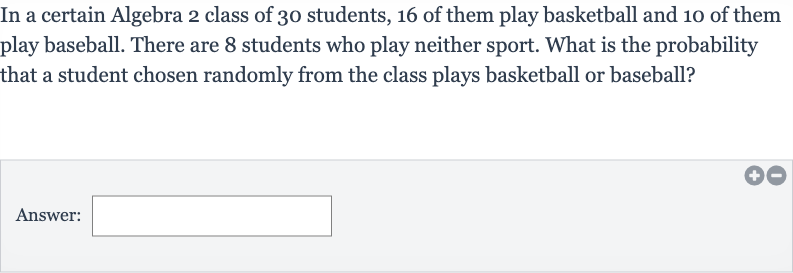AI tutor
Welcome to Bytelearn!
Let’s check out your problem:

In a certain Algebra class of students, of them play basketball and of them play baseball. There are students who play neither sport. What is the probability that a student chosen randomly from the class plays basketball or baseball?Answer:
Full solution
Q. In a certain Algebra class of students, of them play basketball and of them play baseball. There are students who play neither sport. What is the probability that a student chosen randomly from the class plays basketball or baseball?Answer:
- Determine Total Students: First, let's determine the total number of students who play either basketball or baseball. Since some students might play both sports, we cannot simply add the number of basketball players to the number of baseball players. We need to use the principle of inclusion-exclusion.
- Principle of Inclusion-Exclusion: According to the principle of inclusion-exclusion, the number of students who play basketball or baseball is equal to the number of basketball players plus the number of baseball players minus the number of students who play both sports.
- Find Students Who Play Both: We can find the number of students who play both sports by subtracting the number of students who play neither sport from the total number of students, and then subtracting the number of students who play only one sport (basketball or baseball).
- Calculate Students Who Play One Sport: The number of students who play only one sport is the total number of students minus the number of students who play neither sport: students students students.
- Calculate Students Who Play Both: Now, we subtract the number of students who play only one sport from the sum of basketball and baseball players to find the number of students who play both: basketball players baseball players\) students students who play both sports.
- Apply Inclusion-Exclusion Principle: Using the principle of inclusion-exclusion, the number of students who play basketball or baseball is: basketball players + baseball players - students who play both = students.
- Calculate Probability: The probability that a student chosen randomly from the class plays basketball or baseball is the number of students who play basketball or baseball divided by the total number of students in the class.
- Final Probability Calculation: Calculating the probability: students who play basketball or baseball total students .
More problems from Probability of independent and dependent events
QuestionGet tutor help
QuestionGet tutor help
QuestionGet tutor help
QuestionGet tutor help
QuestionGet tutor help
QuestionGet tutor help
QuestionGet tutor help
QuestionGet tutor help
QuestionGet tutor help
